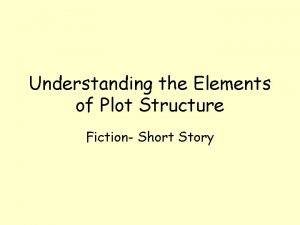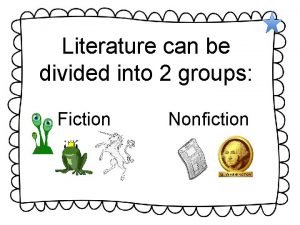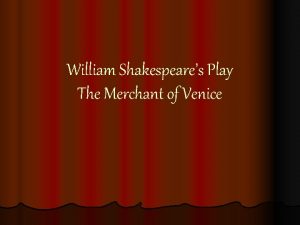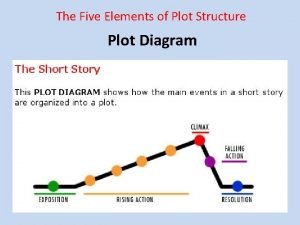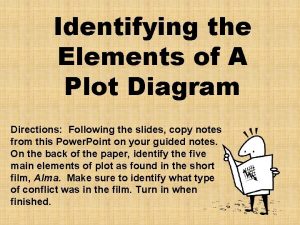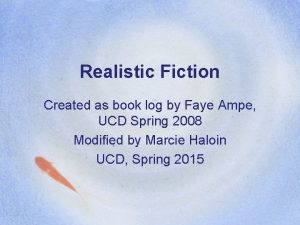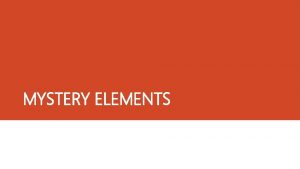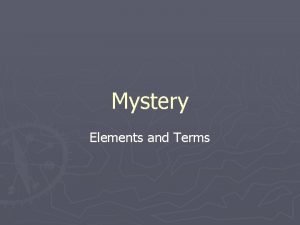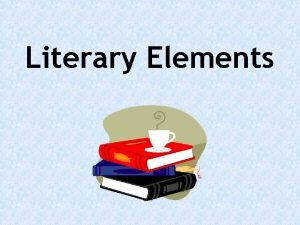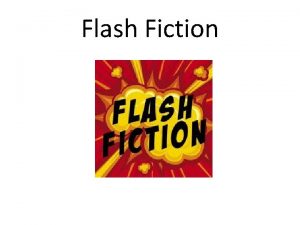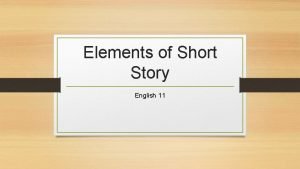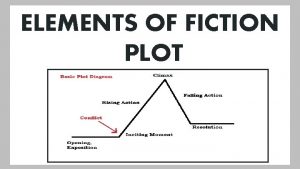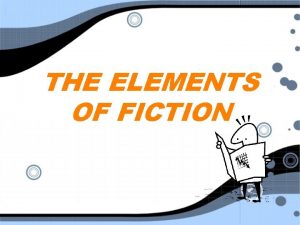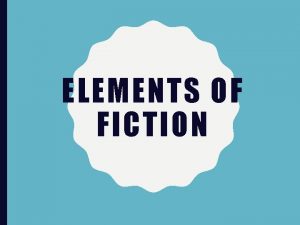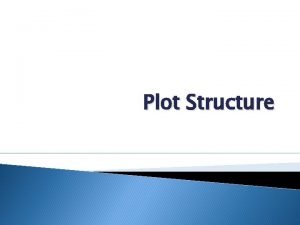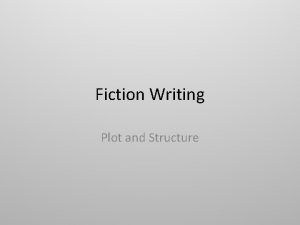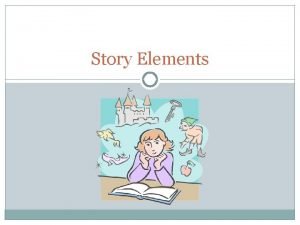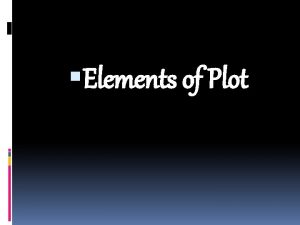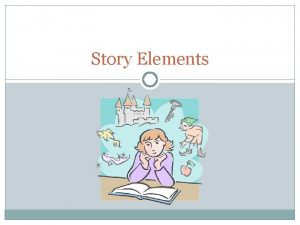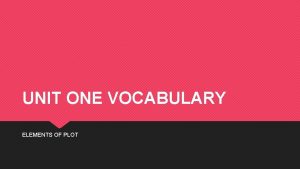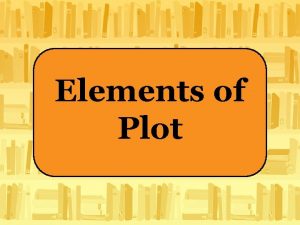Elements of Fiction Plot Structure What makes a















- Slides: 15

Elements of Fiction: Plot Structure What makes a book tick? How does a write assemble a story?

Many stories follow a pyramidal shape of conflict, suspense, action, and resolution

Please choose TWO of the following links below to learn about the plot pyramid. Take notes from the videos to fill out your Plot Structure Notes page. Links are arranged from more basic descriptions to more complex • https: //www. youtube. com/watch? v=WH 5 jlk. K 4 a. UI • https: //www. youtube. com/watch? v=PL 0 OByb. Fu 2 I • https: //www. youtube. com/watch? v=Sv. FB 6 XVb. SAY • https: //www. youtube. com/watch? v=Ty 1 A 7 N_typc

Of course, there’s lots that happens in a story, and frequently a story’s action rises FAR higher than it will fall. So many stories look more like this:

A cliffhanger might lack a proper resolution!

Here are some other (perhaps more realistic) story pyramids: • Can you think of a type of story that might fit this diagram?

Here are some other (perhaps more realistic) story pyramids: • Can you think of a type of story that might fit this diagram?


With that information, you’ll be set to fill out most of your homework page. But there’s one question remaining, and this is when things start to get REALLY interesting…

What makes a story go? Plot is the engine of the book. (And conflict is the engine of plot!)

There are 2 main types of plot: How WRITER makes story move along Event-based plot: Character-based plot: • Typically what we think of when we think “plot” • Writer’s main purpose is to discover or explain • Events in the story, or happenings, move story along • The writer is working towards a certain end goal, or with certain events in mind, “This is going to happen, then this, then oooh! What if ____ happened!” something about human nature • Writer’s main goal in this story is to make characters change and grow. In the process, the writer might hope to explain or discover something about humans in general. • Examples: Mysteries, detective stories, adventure • Writer asks, “What would happen in if. . . someone new • Story comes first. It’s more about the story, not the • Comparison: Plot is a little more like a branching tree. novels, analogies, concept or idea-based novels, nonfiction, news articles people in it. The characters are more an aspect of this story, who it should happen to. They may not be the reason for this story’s existence, but crucial actor, hero, or discoverer of crime. • *Plot-based novels are like beads on a necklace. The complete story = string of events. moved to town, character gets a new relationship, someone gets sick, loses job, or moves away… The author starts following branches of what COULD happen to the main character, and continues some while discarding others. There are different potential events and endings, because author’s main goal is to explore something larger about life, family, love, or a certain person. • You can see how particular events might not be as crucial to this sort of story, or they order they happen in. Just that they all cause change over time. You can’t mess with the order of events in a detective novel, but you could, perhaps, in Habibi

Of course, most books use both. But sometimes a book falls completely into one camp or the other, depending on the author’s purpose in writing. Does author want to tell a sweeeeet campfire story? Or explore what human nature is like? ( I love BOTH kinds of stories, personally. But I might prefer characterbased plots. Those have been the books to take off the top of my head and rearrange what’s inside. But on the other hand, I do love a riveting story…)

Examples: Event-based plots: Character-based plots: • Ellen Raskin: The Westing Game (mystery) • Naomi Shihab Nye- Habibi • Redwall series- Brian Jacques • Sharon Creech: Walk Two Moons, Bloomability, Love That Dog, The Wanderer • Gary Schmidt: The Wednesday Wars, Okay For Now, First Boy, Orbiting Jupiter • Smile, Sisters, Drama- Raina Telgemeier • Roller Girl- • Fish In a Tree- Lynda Mulaly Hunt • Kate de. Camillo- Despereaux, Raymie Nightingale, Flora & Ulysses • Amy Tan: The Joy Luck Club, The Kitchen God’s Wife • Nancy Drew, Hardy Boys, Boxcar Children • Junie B. Jones, Judy Moody • Superhero stories- Batman, Spiderman, Wonder Woman show up for a new episode of the same sort of adventure • Comedy stories- Spongebob, Archie, My Life As A…, I Survived series

Both event & character-based plots: • Unwanteds- Lisa Mc. Mann • Unwind series- Neal Shusterman • Harry Potter- In large overarching plot structure and subplots of each book, you can kind of see the master mystery-writer’s hand at work. And yet, it IS about character development. And adding things to make them change…) Fun Fact: Did you know J. K. Rowling has written a whole pile of books? Her pseudonym is Robert Galbraith. Post on the blog if you’ve read any!

Cues & Clues- which is which? Event-based plot: Character-based plot: • Main character is probably static (detective back on the job, superhero saving people, Spongebob back for more disaster and laughs) • Main character is dynamic: Liyana and Harry Potter CHANGE and GROW over course of the story(s) • Can you outline a typical plot? If you can predict the type of event to happen next (ex: search for criminal, fight scene, overblown argument) you might be reading an event-based novel (*Not all event-based plots are predictable!) • These stories are can be predicted as well…but maybe less easily. More like general expectations than knowing what will happen • Ex: Habibi • Ex: Detective story starts with crime, then we are introduced detective, clues and characters, probably some action, then at the end, detective solves case. • Personal example: When I used to read Nancy Drew, at some point I figured out that when Nancy wound up falling unconscious (gagged in a closet, for example) in meant she was THIS close to solving the crime! • Can you outline a typical series of events for a Spiderman episode? For Spongebob? Liyana is faced with a change in circumstances. We can expect life will be hard at first, then probably easier as she gets used to it. And then…maybe she’ll make friends? Maybe she’ll decide to stay? Maybe there will be a crisis and she will still decide to stay? Or come home? Reading this book I did not predict bathtub smashing or jail incident. After reading I could see, “Oh, writer was adding a real crisis. So we can see how Liyana has changed. ” But I didn’t know what form that crisis would take. I didn’t know the way I know Batgirl would hunt down the bad guys, even if they escaped at the end.
 What are the elements of fiction and nonfiction
What are the elements of fiction and nonfiction Plot structure of fiction
Plot structure of fiction It is a genre of speculative fiction dealing
It is a genre of speculative fiction dealing Contemporary realism literature
Contemporary realism literature Fiction and non fiction examples
Fiction and non fiction examples Denouement of merchant of venice
Denouement of merchant of venice The merchant of venice plot diagram
The merchant of venice plot diagram 5 elements of plot structure
5 elements of plot structure The elements of plot
The elements of plot Elements of realistic fiction
Elements of realistic fiction Elements of realistic fiction
Elements of realistic fiction Mystery
Mystery Story elements cinderella
Story elements cinderella Flash fiction
Flash fiction What are five elements of a short story
What are five elements of a short story What are the 7 elements of science fiction
What are the 7 elements of science fiction

